Mastering Microsoft Advertising’s Auction Insights Tool

Microsoft Advertising’s Auction Insights tool provides valuable data on competitors’ strategies and performance, empowering advertisers to make informed decisions and optimize their advertising efforts for better outcomes.
Read on to learn how to leverage this powerful feature to stay ahead of your competition.
What is an auction insight report, and why does it matter?
The Auction Insights tool offers a comprehensive breakdown of various data points, including the frequency of your ads’ appearances, their placement, and instances when you outrank the competition. This information can be leveraged to enhance your campaigns and achieve better results without increasing your budget.
Additionally, the auction insights report retains data for 180 days, allowing for a thorough analysis of trends and performance and enabling you to increase your position and audience reach.
By analysing the auction insights metrics, you can :
1. Identify the competitors participating in the auctions you’ve engaged in over a specific period.
2. Assess the level of competitiveness between your ads and those of other advertisers.
3. Determine the positions of your ads in comparison to other advertisers’ ads.
Let’s explore how to use auction insights in your Microsoft Advertising account:
How to access the auction insights report?
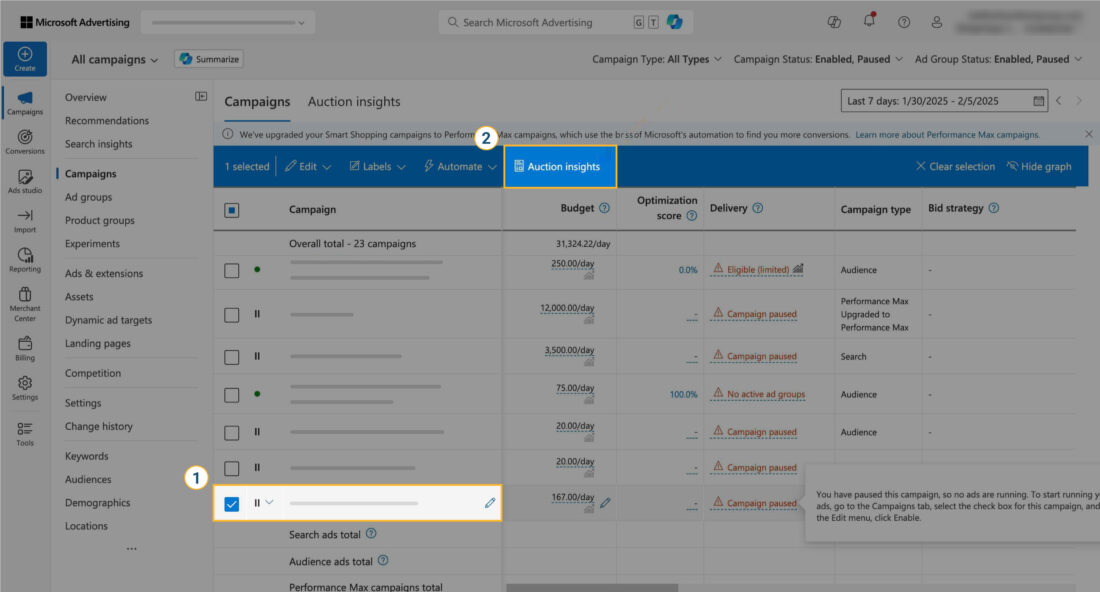
- Log in to your Microsoft Advertising account.
- Go to the Campaigns section & select the specific campaign you want to analyse.
- Then click on ‘Auction Insights’ to view the metrics.
Note: The auction insights report will only run if you have enough impressions. If it’s a new campaign or you have too few impressions, the report will not be generated.
Six key metrics and their importance in Ad campaigns
There are six key metrics available in Microsoft Advertising’s Auction Insights report. These key metrics help to:
- Understand how changes in the metrics can affect your approach toward running a campaign.
- Spot trends to tweak your bidding, keywords, and ad creatives.
Here’s how you can interpret each key metric for competitor analysis.
1. Importance of “Impression Share” in your campaign performance
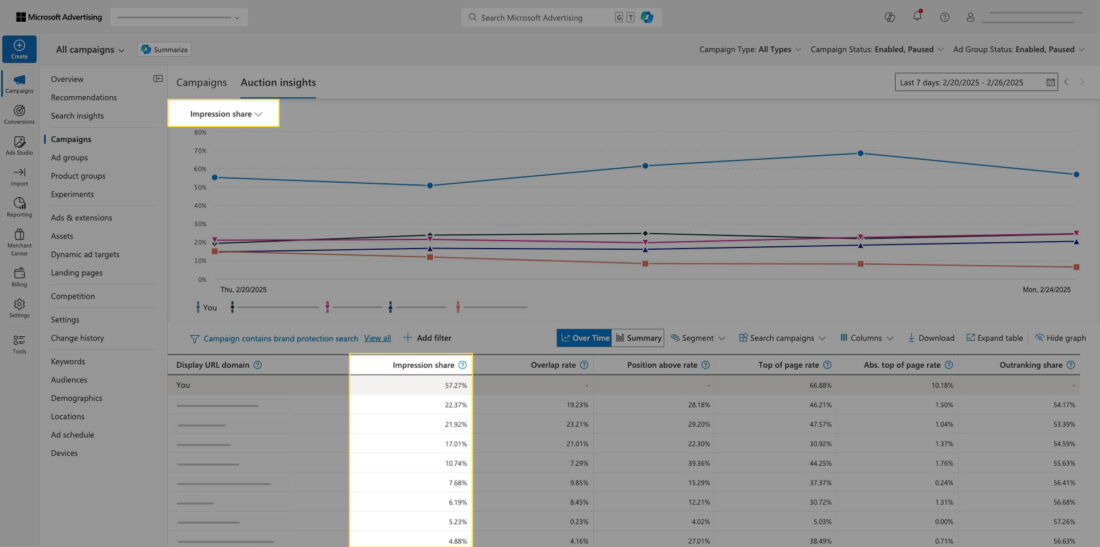
Impression share is the number of impressions you received divided by the estimated number of impressions you were eligible to receive.
The eligibility of impressions depends on your current ads’ target settings, approval status, and quality scores. This helps to improve your ad quality score.
To calculate the impression share, follow the formula below:
[Impression share = Your impression / Total eligible impressions ✖️100%]
For example, if your ad was eligible for 5,000 impressions and received only 1,000 impressions, your impression share is 20%.
Low impression share helps you identify areas where you can improve your ad performance, and a strong impression share signifies a strong market presence but also requires an analysis of return on investment to ensure you’re not overspending on visibility.
2. How the “Overlap Rate“ helps you identify competitor visibility
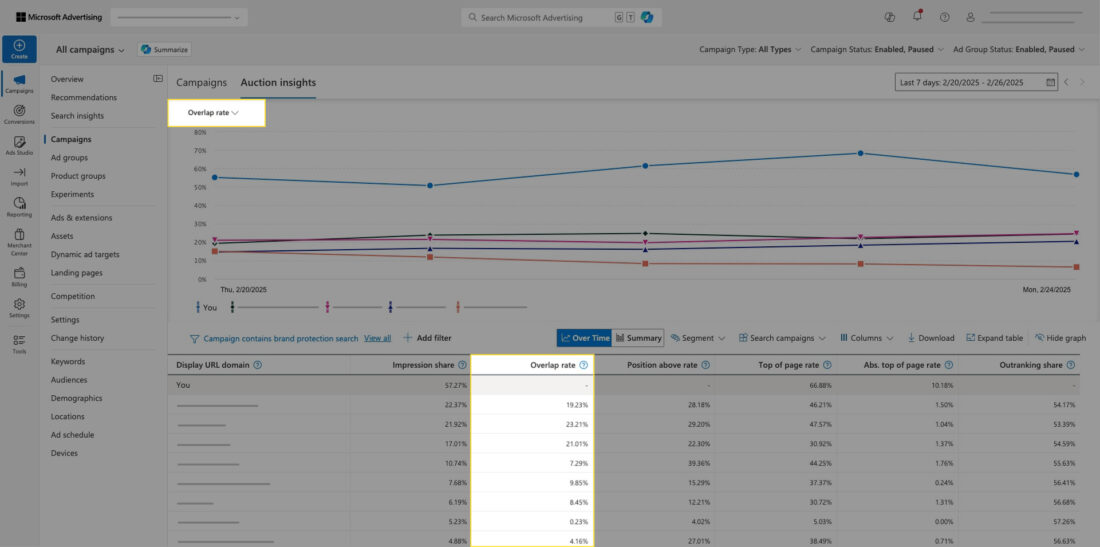
The overlap rate shows how often a competitor ad appears in the same auction that your ad also received an impression on.
However, the overlap rate does not directly indicate who is above or below in position. Instead, it simply measures how often both ads are triggered by the same search.
For example, if one of the competitors in your Auction Insights report is showing 60% in the Overlap Rate column, this means that in 6 out of every 10 times your ad showed, an ad from this competitor also showed.
If you notice a high overlap rate percentage with a competitor, analysing their strategies, ad messaging, and keywords helps you to change or refine your approach.
3. “Outranking Share” helps to know about competitive positioning
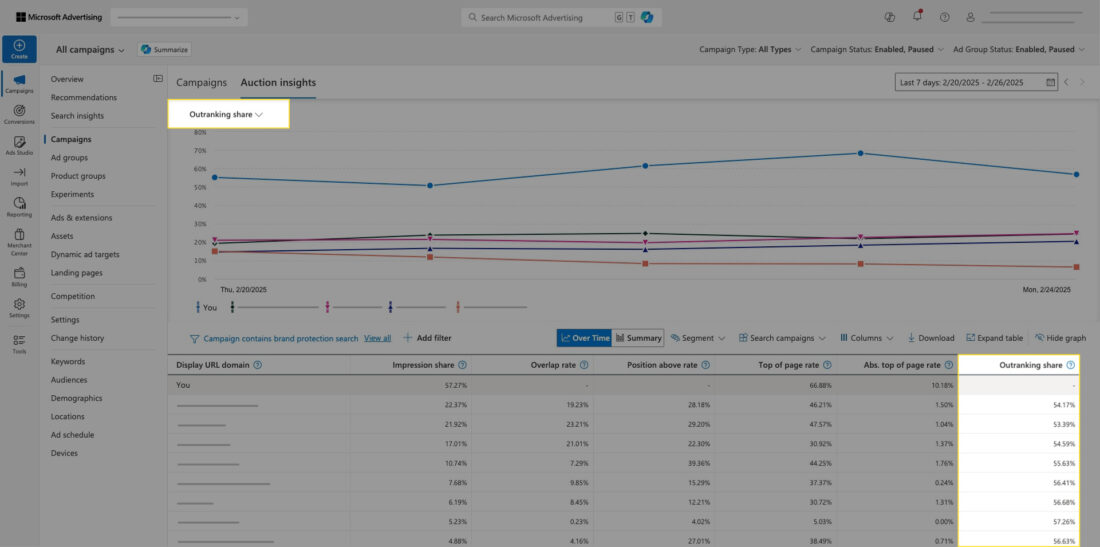
Outranking share refers to the percentage of times your ad appears in a higher position than a competitor’s ad when both ads are shown together on the search result page.
For example, an outranking share of 20% means you outranked your competitor 20 times out of every 100 times your ads appeared together.
Use outranking shares to determine how often your ad appears among competitors.
4. “Position Above Rate” helps to track your ad’s visibility compared to competitors
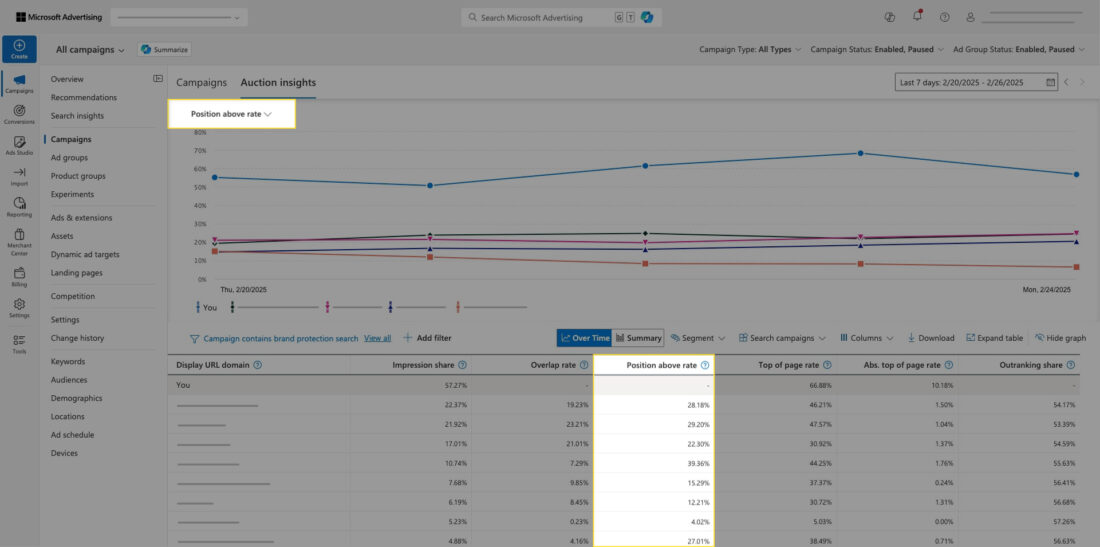
The position above rate indicates how often a competitor’s ad appears higher than your ads when both ads are shown at the same time on the search result page.
For example, if one of the advertisers in your auction insights report is showing 15%, this means that the other advertiser’s ad showed in a position above yours 15 out of every 100 times your ads showed at the same time.
Adjust your bids/targets or optimise your ad copy and landing pages to improve your position on the search result page.
5. Importance of “Top-of-page rate” in measuring your ad rank on search results
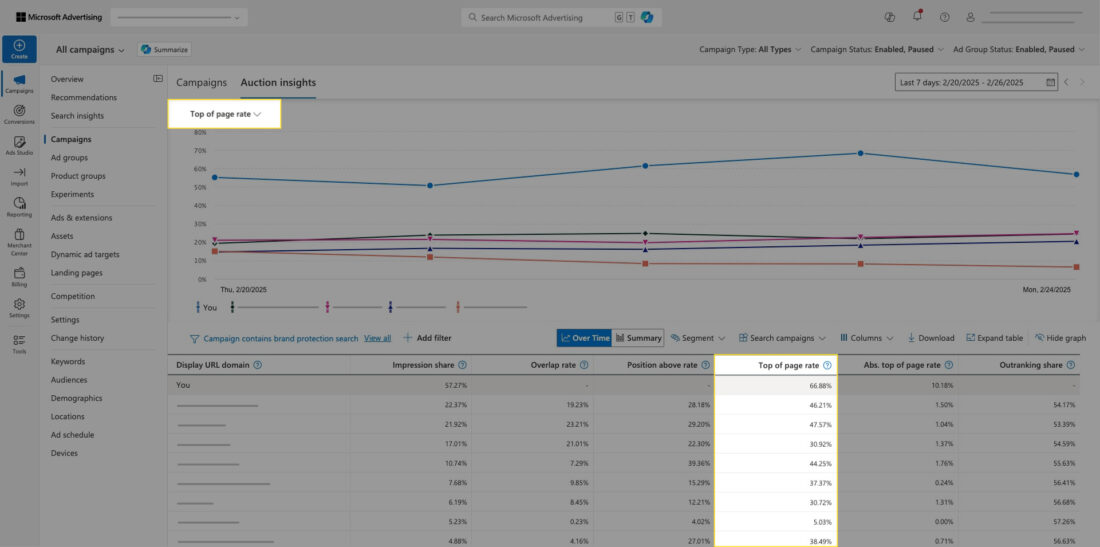
The top-of-the-page metrics show the number of times an ad appears at the top of the page over your competitor’s advertisement. Ads at the top of the page receive more clicks.
For example, if you had 100 impressions, out of which 20 impressions appear in any of the top positions above the organic search results, the top-of-page rate will be 20%.
6. “Absolute Top-of-page rate” impacts your ad visibility on the first search page
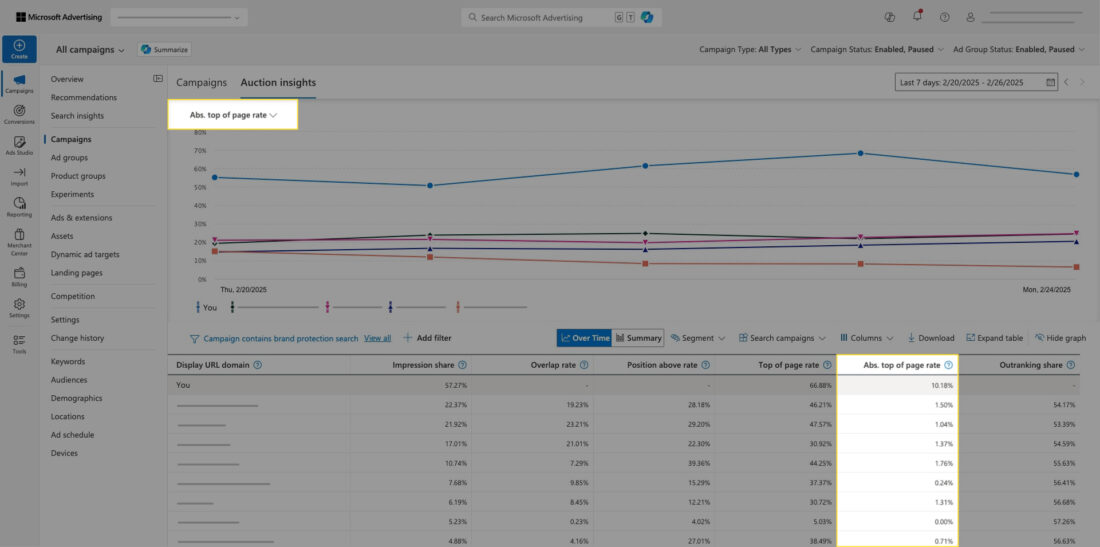
The Absolute top-of-the-page rate shows how often your ad shows up at the absolute top position on the search result page.
For example, if your absolute top-of-page rate is 20%, your ad was shown as the first result 20 out of every 100 times.
Turning Insights into Actions
Now that you understand the key metrics, it’s time to put them to work.
Here are some insightful tips:
>> Ensure your keywords are relevant to what your customers are searching for, & optimise your product data feed.
>> Improve your ad relevance and quality scores to get a competitive edge.
>> Test different bidding strategies and ad schedules to find the most effective combinations.
>> Use negative keywords to avoid irrelevant traffic and wasted ad spend.
Submitting a detailed and accurate product feed to Microsoft Advertising’s account boosts ad relevance and makes your products show up at the right time for the right audience.
But how do you handle this without running into a bunch of hurdles? That’s where automated feed management tools like Simprosys Shopping Feed come in. It’s your behind-the-scenes assistant, effortlessly optimizing and managing your product feeds.
Who wouldn’t want a tool that makes everything run smoother and helps you get the best results possible?
Your Competitive Edge
Microsoft Advertising’s Auction Insights is your gateway to making smarter, more strategic decisions. By continually analyzing these metrics, you can optimize your ad performance, maximize your return on investment, and stay ahead of the competition.
So, keep a close eye on these metrics because your competitors are always evolving.
In our next blog post, we will discuss how to analyze the Auction Insight metrics for the Performance Max campaigns to take your auction insight metrics to the next level. Start utilizing auction insights to harness the power of metrics that drive strategic optimisation decisions.



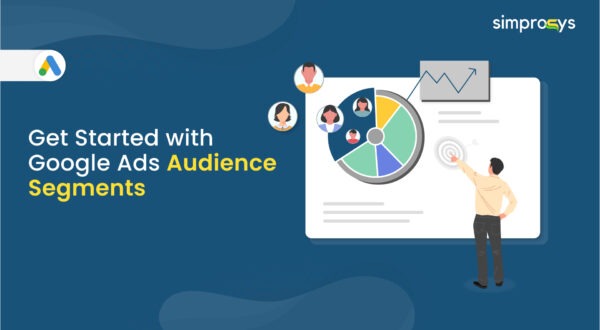
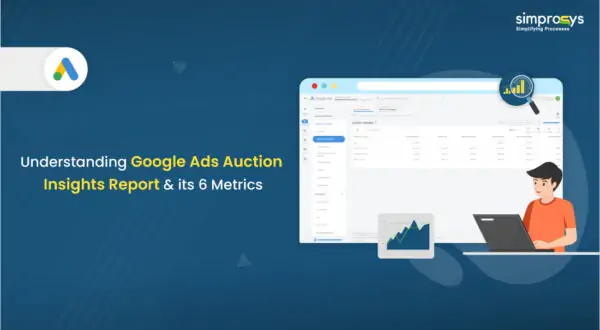
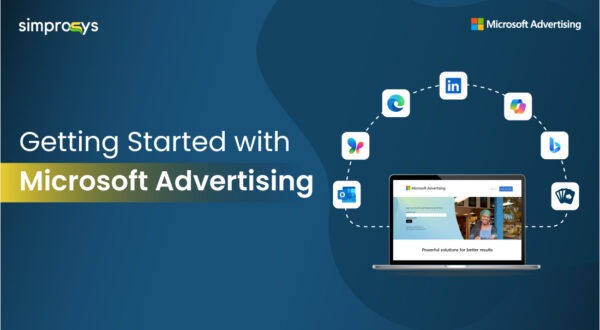
Leave a Reply